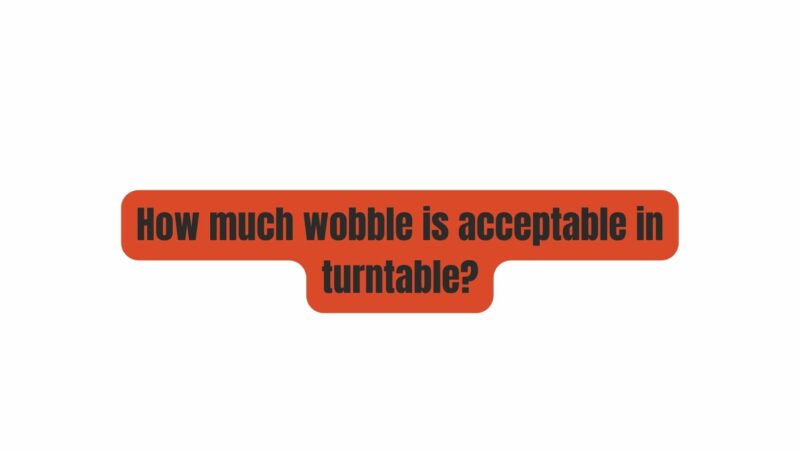Vinyl records, with their warm and authentic sound, have experienced a resurgence in popularity. For audiophiles and music enthusiasts, the joy of placing a vinyl record on a turntable and experiencing the analog magic is unmatched. However, there’s one aspect that often concerns vinyl lovers: turntable wobble. How much wobble is acceptable in a turntable? This question delves into the heart of the vinyl experience, as the answer can significantly impact sound quality and overall enjoyment. In this article, we will explore the factors that contribute to turntable wobble, the impact it has on your listening experience, and how to determine what level of wobble is acceptable.
Understanding Turntable Wobble: Causes and Variations
Turntable wobble, also known as wow and flutter, refers to the irregular rotation of the turntable platter. It can manifest as slight speed variations or more pronounced wobbling, and its causes can be multifaceted:
- Belt-Driven vs. Direct Drive Turntables: Turntables are typically classified into two categories: belt-driven and direct drive. Each type can experience wobble for different reasons.
- Belt-Driven Turntables: These use an elastic belt to connect the motor to the platter. Over time, these belts can stretch, wear out, or become misaligned, leading to speed inconsistencies and wobbling.
- Direct Drive Turntables: While direct drive turntables have the motor directly connected to the platter, they can still experience wobble due to motor issues, bearing problems, or damaged platter components.
- Uneven Surfaces: The surface on which your turntable is placed plays a significant role in wobble. Placing your turntable on an uneven or unstable surface can lead to wobbling during playback.
- Platter Imbalance: If the platter or the record itself is not balanced correctly, it can cause wobbling during playback.
- Dust and Debris: Accumulated dust and debris on the turntable’s components, such as the platter or the motor, can lead to irregularities in rotation speed.
The Impact of Wobble on Sound Quality
Wobble, even in small amounts, can have a noticeable impact on the sound quality of your vinyl records. Here are the key ways in which turntable wobble affects your listening experience:
- Pitch Variation: Wobble can cause pitch variations, making the music sound flat or sharp at different points during playback. This can be especially noticeable with instruments like pianos or vocals.
- Flutter: Flutter refers to rapid, cyclical variations in playback speed. It can create an audible warbling or flapping effect in the sound, disrupting the musical flow.
- Loss of Detail: Wobble can result in a loss of detail and clarity in the music. Subtle nuances, such as the decay of a note or the texture of an instrument, may not be faithfully reproduced.
- Listening Fatigue: Prolonged exposure to wobble can lead to listening fatigue, as your brain tries to compensate for the irregularities in sound.
- Record Wear: Wobble can cause uneven wear on your records, leading to decreased longevity and potential damage to the grooves.
Determining the Acceptable Level of Wobble
The acceptable level of wobble in a turntable can vary depending on several factors, including your personal preferences, the quality of your audio equipment, and your familiarity with vinyl records. Here are some guidelines to help you determine what level of wobble is acceptable for your listening experience:
- Personal Tolerance: Your personal tolerance for wobble plays a significant role in what you find acceptable. Some listeners are highly sensitive to even slight variations in sound quality, while others may be more forgiving.
- Turntable Quality: High-end turntables are designed to minimize wobble and deliver exceptional sound quality. If you have invested in a high-quality turntable, you may expect near-zero wobble.
- Musical Genre: The genre of music you typically listen to can also influence your tolerance for wobble. Some genres, such as classical or jazz, may benefit from minimal wobble to preserve the delicate nuances of the music.
- Listening Environment: Consider the environment in which you listen to your vinyl records. A quiet, dedicated listening room may amplify any wobble, while a less controlled environment may mask it to some extent.
- Turntable Maintenance: Regular maintenance of your turntable can help reduce wobble. Proper belt tension, platter balancing, and motor upkeep are essential for minimizing wobble.
Reducing and Minimizing Wobble
Regardless of your acceptable tolerance for wobble, it’s always beneficial to minimize it as much as possible to enjoy the best possible sound quality from your vinyl records. Here are some steps to reduce and minimize wobble:
- Belt Replacement: For belt-driven turntables, periodically replace the belt following the manufacturer’s recommendations.
- Direct Drive Maintenance: Maintain your direct drive turntable by addressing any motor issues, bearing problems, or damaged platter components promptly.
- Stable Setup: Ensure your turntable is placed on a stable, level surface to minimize the risk of wobbling.
- Platter Balance: If the platter is imbalanced, make the necessary adjustments to ensure it is evenly weighted.
- Regular Cleaning: Clean your turntable, platter, and tonearm regularly to prevent dust and debris buildup.
- Professional Calibration: Consider having your turntable professionally calibrated and serviced periodically to maintain optimal performance.
Conclusion
The acceptable amount of wobble in a turntable is a subjective matter influenced by personal preferences, the quality of your equipment, and your listening environment. While some listeners may tolerate a certain level of wobble, others may demand near-perfection in sound quality.
Regardless of your tolerance, it’s essential to minimize wobble to ensure the best possible listening experience. Regular maintenance, proper setup, and attention to detail can go a long way in reducing wobble and preserving the integrity of your vinyl records. Ultimately, the goal is to achieve a balance that allows you to enjoy the rich, analog sound of vinyl records without being distracted by unwanted variations in playback speed and pitch.

